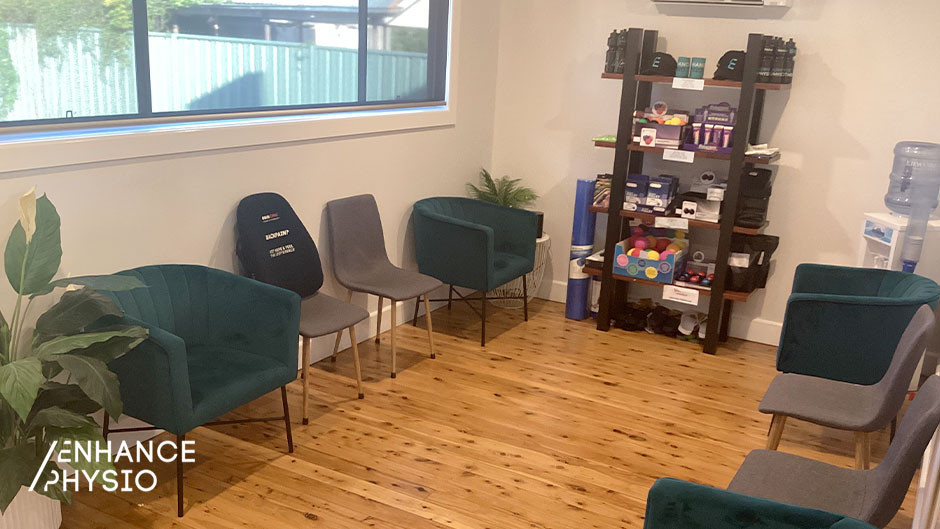Enhance Physiotherapy offers physiotherapy solutions for patellofemoral pain
Patellofemoral pain (PFP) is a condition that affects the knee joint. It is one of the most common causes of knee pain in young adults and can significantly affect quality of life. Many people with PFP experience anterior knee pain, tenderness around the kneecap, and difficulty straightening the leg. If you are experiencing symptoms of PFP, book an appointment with Enhance Physiotherapy today! We can help you get back to feeling like yourself again!
At Enhance Physiotherapy Wodonga we specialize in physio treatments for patellofemoral pain (PFP) or headaches. Our team of highly skilled physiotherapists will work with you individually to create a treatment plan tailored specifically for you. This may include exercises to strengthen your muscles around the knee joint, manual therapy such as massage or stretching, taping techniques, and education on how best to manage your symptoms. Book an appointment today at our clinic in Wodonga – we would be happy to help you get back on your feet!
Effectively manage patellofemoral pain with physiotherapy
Do you experience pain in your knee during or after activities such as running, squatting, or climbing stairs?
If so, you may have patellofemoral pain syndrome (PFPS). PFP accounts for 11-17% of all knee pain presentations to general practice, and it typically occurs in physically active people aged <40 years.
It is a very debilitating condition in jumping athletes, with previous research indicating that 1/3 of athletes presenting with the condition were unable to return to sport within 6 months.
Patellofemoral pain syndrome is a common problem that can, fortunately, be effectively managed with physiotherapy.
So if you are experiencing pain in and around your knee cap, you should consult a physiotherapist for a professional biomechanical assessment and treatment plan.
What is Patellofemoral Pain Syndrome?
Patellofemoral pain syndrome (PFPS) refers to pain in the front of the knee, around or behind the kneecap.
This pain is typically caused by contact between the kneecap and the thigh bone (femur), which can affect the joint surface over time.
PFPS, also known as “runner’s knee,” is common in active people who participate in sports but can also occur in non-athletes.
The pain and stiffness caused by PFPS can make walking, kneeling, squatting or running difficult.
This knee pain is aggravated by jumping, landing and kicking and is almost always alleviated with the cessation of the aggravating activity.
Common symptoms of patellofemoral pain syndrome
- Patellofemoral pain syndrome is characterised by a dull, aching pain in or near the kneecap.
- There may also be a reduction in knee range of motion.
- Running, jumping, hopping, squatting, and kneeling are frequently painful motions for people with PFPS.
- There may be some swelling and a loss of muscle strength around the knee.
- The onset of pain is usually gradual rather than abrupt or traumatic.
- Structures around the knee, especially on the outside, may feel restricted.
- The pain symptoms are most noticeable during exercise and weight-bearing activities that involve knee bending.
- Pain can also be felt after sitting with the knees bent for long periods.
Common causes of patellofemoral pain syndrome
Patellofemoral pain syndrome is caused by the patella failing to track properly on the femur when the knee is bent and straightened.
Muscle imbalances – thigh or buttock weakness, hamstring or ITB tightness.
Overuse – abrupt changes in activity level or intensity.
Biomechanics – excessive pronation of the feet/ankles, hip and knee joint angle.
Recent evidence suggests that hip weakness is the underlying cause of the dysfunction. Research also shows that poor hip abductor strength was a risk factor for future PFP pain in novice runners.
The truth is that there is likely no single mechanism causing PFPS but rather several dysfunctional biomechanical patterns that may overload tissue in this area.
These patterns can develop for various reasons, including weakness of the lower limb’s stabilising muscles or simply adopting poor gait patterns.
The 4 fundamental principles to ensure effective PFPS management
- PFPS is a multifactorial condition requiring an individually tailored program.
- Immediate pain relief should be a priority.
- Patient empowerment by emphasising active over passive interventions is essential.
- Good patient education and activity modification are essential.
Physiotherapy treatment for patellofemoral pain syndrome (PFPS)
An individualised treatment plan will be designed and implemented based on the information obtained during your physiotherapy consultation. This will consider the irritability of your patellofemoral joint and the deficits identified during your physical assessment.
Patellofemoral pain physiotherapy treatment includes:
- Taping techniques for reducing the g load on the patellofemoral joint.
- Mobilisation of the knee cap.
- Modification of activities and load management.
- Orthotics are used to improve foot posture and biomechanics.
- Muscle strength is gradually increased, focusing on the glutes, quads, and calves.
- To increase the flexibility of the tissues surrounding the patellofemoral joint and treat pain, we use manual therapy techniques like soft tissue massage and dry needling.
- Training for movement patterns and gait will help correct any compensatory movement patterns that exacerbate knee pain and retrain the body’s proper biomechanics for walking and running.
Most people will have noticeable improvement in their pain and function within 6-12 weeks of starting a multi-modal approach, as described above. Still, older people with a long history of pain need to expect a more extended recovery period.
Final Thoughts on Physiotherapy Management For Patellofemoral Pain Syndrome (PFPS)
Education, orthotics, dry needling, and load management are essential features of PFP management.
Exercises to strengthen the gluteal and quadriceps musculature, manual therapy, and taping possess the most substantial evidence.
Combined, hip and knee strengthening exercises are superior to knee exercises for treating PFP in the short and long term.
Enhance Physiotherapy’s skilled physiotherapists can thoroughly examine you for specific deficits causing your PFP and implement a treatment program to get you feeling and performing better.
Book an appointment with one of our highly qualified physiotherapists at Enhance Physio before starting a rehabilitation program. We can advise you on the best course of action for your condition.
Enhance Physio provides services in Wodonga Physiotherapy
Wodonga is a quaint Australian city that sits on the Victorian side of an international border with New South Wales, 300 kilometers northeast of Melbourne. This tranquil little town has all you need for your perfect getaway: plenty to see and do in both cities or country living; great local food and wine; and all the peace, quiet, and relaxation you could want.
Enhance Physio is only a few minutes away if you live in Wodonga and seek Physio Wodonga. Contact Enhance Physio at (02) 6060 2403 or book a consultation online, and let us help you with your headaches or any other issues related to your health.




































